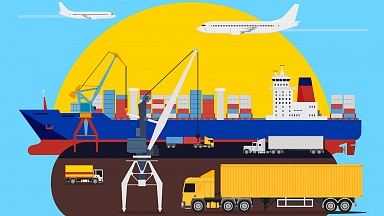The last couple of years have been a rollercoaster ride for the shipping industry; from skyrocketing rates in early 2022 to rock bottom prices this year. Will we see a recovery in 2024 from a container liners’ perspective? The general consensus is no, though optimism is not entirely absent. Meanwhile, there are a myriad of other influential factors that are set to come to the fore in 2024, including interest rates, environmental regulations and geopolitical uncertainty.
A continuation of low rates
The bad news for players in the sea freight industry is that few analysts believe a noticeable upturn in rates is on the cards. The main reason for this is simply continued imbalance when it comes to supply and demand.
Among those to come to this conclusion are Container xChange, whose 2024 report forecasts «reduced demand and oversupply» that could potentially lead to «fierce competition, reduced profits, and possible mergers and acquisitions.»
BIMCO’s 2024 forecast also offers a similar projection for next year: Supply is forecasted to grow at an average annual rate of 8.4% between 2023 and 2025. Even at the best of times, ship demand would not see similar growth. The forecast therefore predicts that the weakening that began in 2022 and took hold in 2023 will continue also in 2024 and 2025.
Moreover Drewry is expecting demand to basically move sideways next year. We are forecasting only minor growth for global port throughput of around 2%. The fleet is going to grow about 3 times faster than that. You’ve got the bill due on the huge new building spending spree from the pandemic, and that’s going to be now the 3rd year running when fleet growth has exceeded demand. So that’s going to compound market over-capacity that we think will hit record lows next year. So this is all going to put very heavy downward pressure on freight rates.
The importance of interest rates
Another visible constant among the 2024 shipping forecast commentary is the influential role that interest rates are expected to have on demand.
Commenting on what 2024 will have in store for the freight market, Matt Elenjickal, founder and CEO of supply chain visibility provider FourKites, told that softness in the freight market will continue for far longer than usual, likely throughout all of 2024, due to persistent, higher interest rates.«
The aforementioned BIMCO report also touched on this, adding that slower demand growth could be seen in 2024 if central banks need to take interest rates even higher to control inflation. On the other hand, a lowering of interest rates starting in 2024 could result in an upside for 2025.
Blank sailings
Given the desperate need to stop rates from falling even further, or remaining at unsustainable levels, most industry experts believe that blank sailings and other mechanisms will have to be utilised by major container liners.
Xeneta CEO Patrik Berglund is one who believes that this is very much the case. He asks to think about underlying weak macro-economics; inflation rates, cost of living, interest rates and reduced global consumption. On top of that you have wider political turmoil and wars. There are still some heavy dark skies on the horizon, and that could change the equation. But he still believes shipping lines will adjust to whatever demand is out there because anything else does not make sense.
Geopolitics and supply chain diversification
The importance of the geopolitical climate is something that is well documented in the aforementioned reports too.
Container XChange notes that geopolitical uncertainties, such as conflicts in Ukraine, Taiwan, and Israel, are impacting trade routes. Meanwhile, the organisation adds that the expansion of BRICS countries is introducing new dynamics. Additionally, BIMCO states that companies are diversifying away from China, driven by ongoing trade tensions, rising labour costs, and concerns about supply chain resilience.
Peter Sand, Chief Analyst at Xeneta, also warns that political turmoil and conflict could have a significant impact next year. He believes that the geopolitical wild card could come into play. Political turmoil and wars are ongoing and we are now seeing conflict and heightened tension across the Middle East. Further conflicts in other parts of the world, for example Taiwan, cannot be ruled out and may yield significant and lasting impacts on shipping.
Environmental regulations
Finally, the impact of environmental regulations like ETS has received a fair amount of attention.
According to Xeneta CEO Patrik Berglund, the new environmental regulations being introduced in 2024 are «an additional complication for carriers in what is an already challenging market.»
These changes didn’t pass by Drewry either. As he puts it, there is a lot of regulatory change coming next year. He notes that besides ETS, ships will get their first grades from the carbon intensity indicator scheme. Moreover, he stresses how in April, lines are going to lose their consortia block exemption that they’ve had for a number of years.



